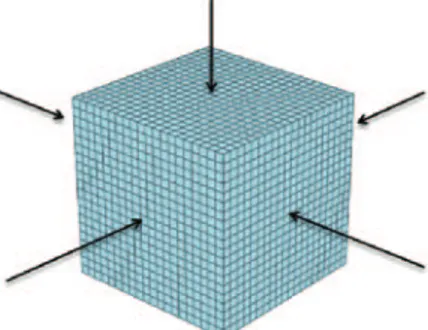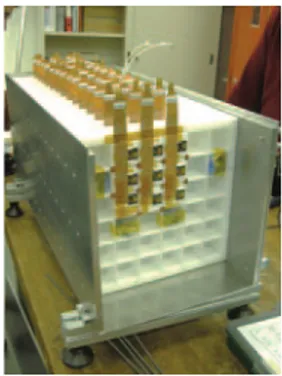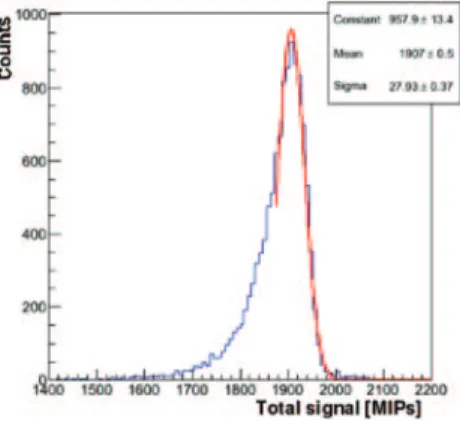(1) INFN Pisa - Largo Bruno Pontecorvo 3, I-56127 Pisa, Italy
(2) Department of Physical Sciences, Earth and Environment - I-53100 Siena, Italy received 21 April 2018
Summary. — The direct observation of high-energy cosmic rays, up to the PeV
region, will depend on highly performing calorimeters, and the physics performance will be primarily determined by their geometrical acceptance and energy resolution. Thus, it is fundamental to optimize their geometrical design, granularity, and ab-sorption depth,with respect to the total mass of the apparatus, probably the most important constraints for a space mission. Furthermore a calorimeter based space experiment can provide not only flux measurements, but also energy spectra and particle identification to overcome some of the limitations of ground based experi-ments. CaloCube is a homogeneous calorimeter whose basic geometry is cubic and isotropic, so as to detect particles arriving from every direction in space, thus maxi-mizing the acceptance; granularity is obtained by filling the cubic volume with small cubic scintillating crystals. A prototype, instrumented with CsI(Tl) cubic crystals, has been constructed and tested with particle beams.
1. – Introduction
The direct measurement of cosmic ray (CR) spectrum in the PeV region is one of the instrumental challenge for the future CR experiments. Indirect measurements on the ground show, around this energy region, a sudden steeping in the inclusive spectrum of particles and a progressively heavier composition, a feature known as the CR knee. So a precise knowledge of particle spectra and composition in this spectral region would allow to address key items in the field of high-energy CR physics. The direct CR detection can permit unambiguous elemental identification and a more precise energy measurement, but suffers from low exposure due to the steepness of the CR spectrum. This limitation prevented the past experiments to go beyond 100 TeV/n for the nuclei and 1 TeV for electron+positron spectra. Direct measurements of cosmic ray proton and nuclei spectra
(∗) E-mail: [email protected]
Fig. 1. – the CaloCube design
up to 1 PeV/n and electron spectrum above 1 TeV require an acceptance of few m2str,
an energy resolution better than 40% for nuclei and 2% for electrons, a good charge identification and a high electron proton rejection power (at least 105).
2. – A novel calorimeter
To achieve the above discussed performances, the major constraint comes from the limitation in weight for the detectors (few tons), which severely affects both the geomet-rical factor and the energy resolution. The R&D project CaloCube aims to optimize the design of a space-borne calorimeter to extend the range of direct CR measurements up to the PeV region in order to measure the knee of the lightest components [1]. The proposed solution consists of a segmented calorimeter made of a large number of cubic scintillating crystals, readout by photodiodes (PDs), arranged to form a cube (see fig. 1). The cubic geometry and the homogeneity provides the possibility to collect particles from either the top or the lateral faces, thus allowing to maximize the geometrical acceptance for a fixed mass budget. The active material provides a good energy resolution, while the high granularity allows shower imaging and provides criteria for both leakage correction and h/e separation [2].
3. – The Monte Carlo simulations
A FLUKA-based model of the calorimeter has been developed, in order to evaluate the expected performances and to optimize the design. A comparative study of differ-ent scintillating crystals has been done, among CsI(Tl), BaF 2, YAP(Yb), BGO and LYSO(Ce). For the hadron detection, the best choice is dictated by the balance between size (density of the absorber) and shower containment (interaction length), which deter-mine the energy resolution. The geometric parameters have been defined by assuming about 2 tons of active material in total; the size of the single cube has been fixed to one Moliere radius and the gap among adjacent elements has been rescaled to obtain the same active volume fraction (∼78%). The signal induced in the PDs by the scin-tillation light has been evaluated by accounting for the light yield of the scintillators, the light collection efficiency on one face, the size and the quantum efficiency of the PD at the emission peak. Direct ionization on the PD has been also considered. Isotropic fluxes of protons hitting one face of the calorimeter have been generated and the effective geometrical factor evaluated. All the five geometries satisfy the basic requirements, by
Fig. 2. – the partially completed prototype used for the tests at CERN.
TableI. – List of tests with different particle beams.
Test Beam Energy
Feb 2013 ions Pb + Be 13–30 GeV
Mar 2015 ions Ar + Poly 19–30 GeV
Aug/Sep 2015 μ, π, e 50, 75, 150, 180 GeV
providing an effective geometrical factor of at least 2.5 m2sr with an energy resolution
better than 40%. 4. – The prototype
To test the CaloCube concept, a prototype with 135 CsI(Tl) cubic crystals of 3.6 cm size, arranged in 15 planes of 3×3 cubes each, with a gap of 0.4 cm between them, has been constructed (see fig. 2). This prototype is found to have a lateral shower containment of about 1.5 Moliere radius and a total depth of 1.35 interaction lengths, corresponding to 28.4 radiation lengths, and has been tested at CERN with different particle beams (see table I).
Signals are readout by means of polyimide flexible printed circuit boards and routed to the front-end board, placed on the side of the calorimeter. The front-end electronics is
Fig. 3. – energy resolution as a function of the ion mass number and of the beam energy, for showers having the same containment.
Fig. 4. – linearity of response as a function of projectile energy, with the nuclei identified by a separate silicon tracker.
based on a high dynamic-range, low-noise ASIC, developed by members of the CaloCube Collaboration. The chosen PD is a large-area (∼100 mm2) sensor that, coupled to CsI(Tl)
crystals and readout electronics, allows to clearly detect minimum-ionizing protons with a signal-to-noise ratio of about 15. One of the most challenging requirements is the very large dynamic range (107) ranging from 20 Mev for minimum ionising protons to 10% of the energy of a PeV proton. This will be accomplished by using also a second small area PD (∼1 mm2).
5. – Tests with ion and electron beams
The first version of the prototype was tested in 2013 and 2015 with ion beams ex-tracted from the H8 line of CERN SPS. The beam contained A/Z = 2 fragments produced by a primary (Pb/Ar) beam colliding with a target (Be/Poly). The experimental set-up included a Si tracking system in front of the calorimeter to provide tracking informa-tion and Z tagging. The single-crystal performances were studied, by selecting non-interacting ions. The responses were equalized by normalizing to the energy deposit of non-interacting He nuclei, the most abundant fragments. The showers developing inside the calorimeter were classified on the basis of the starting point, which can determine the shower containment. Figure 3 shows the energy resolution for different ions at the same shower containment while fig. 4 shows the response of the calorimeter as a function of
Fig. 5. – distribution of the energy deposit (in MIP units) of 30 GeV/n (upper panel) and 13 GeV/n (bottom panel) He ions.
Fig. 6. – measured distribution of total energy (expressed in MIP units) released with a 50 GeV electrons beam, fit with the expected distribution (red curve).
projectile energy for showers initiated before the fifth layer [2, 3]. A Fluka-based model of the prototype has been developed and its predicted response is shown in fig. 5 and fig. 3 (open circles) in comparison with real data. A fine tuning of the Monte Carlo was necessary in order to reproduce the beam-test data. In particular, an additional spread of 4.5% on the single-crystal responses and an optical cross-talk of 14% were introduced. During the beam test at CERN in the summer 2015, the prototype was initially exposed to μ beams to equalize the response of all the cubes that compose the calorimeter. Then an estimate of the energy resolution has been determined exposing the calorimeter to electron beams of different energy and determining the total deposited energy. A prelimi-nary result is shown in fig. 6, referring to a beam of 50 GeV electrons. The corresponding resolution is at a level of 1.5%, in good agreement with the expectation.
6. – Recent developments
A new prototype has been constructed with a completely redesigned mechanics char-acterized by 18 layers, each equipped with a matrix of 5× 5 crystals. The total depth of this new prototype is 1.6 interaction lengths, corresponding to 35 radiation lengths. In this prototype the light signal of each crystal will be read out by two photodiodes, with different sensitive area, in order to cover the full expected dynamic range. This prototype was tested in 2016 with electron and hadron beams at the H4 line of CERN SPS. The analysis of the obtained results is currently under way.
∗ ∗ ∗
This work was supported by the Istituto Nazionale di Fisica Nucleare (INFN), through the CaloCube project, and by the H2020 project AIDA-2020, GA no. 654168. The authors thank CERN for the allocation of beam time at the North Area test facility.
REFERENCES
[1] Bongi M. et al., J. Phys.: Conf. Ser., 587 (2015) 012029.
[2] D’Alessandro R. et al., Nucl. Instrum. Methods A, 824 (2016) 609. [3] Vannuccini E. et al., Nucl. Instrum. Methods, 845 (2017) 421.


